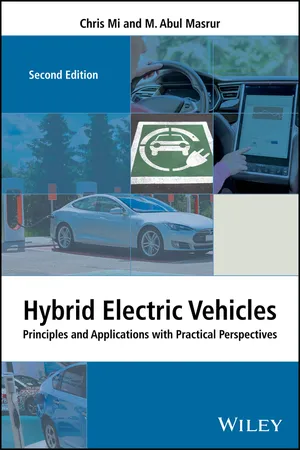
Hybrid Electric Vehicles
Principles and Applications with Practical Perspectives
- English
- ePUB (mobile friendly)
- Available on iOS & Android
Hybrid Electric Vehicles
Principles and Applications with Practical Perspectives
About this book
The latest developments in the field of hybrid electric vehicles
Hybrid Electric Vehicles provides an introduction to hybrid vehicles, which include purely electric, hybrid electric, hybrid hydraulic, fuel cell vehicles, plug-in hybrid electric, and off-road hybrid vehicular systems. It focuses on the power and propulsion systems for these vehicles, including issues related to power and energy management. Other topics covered include hybrid vs. pure electric, HEV system architecture (including plug-in & charging control and hydraulic), off-road and other industrial utility vehicles, safety and EMC, storage technologies, vehicular power and energy management, diagnostics and prognostics, and electromechanical vibration issues.
Hybrid Electric Vehicles, Second Edition is a comprehensively updated new edition with four new chapters covering recent advances in hybrid vehicle technology. New areas covered include battery modelling, charger design, and wireless charging. Substantial details have also been included on the architecture of hybrid excavators in the chapter related to special hybrid vehicles. Also included is a chapter providing an overview of hybrid vehicle technology, which offers a perspective on the current debate on sustainability and the environmental impact of hybrid and electric vehicle technology.
- Completely updated with new chapters
- Covers recent developments, breakthroughs, and technologies, including new drive topologies
- Explains HEV fundamentals and applications
- Offers a holistic perspective on vehicle electrification
Hybrid Electric Vehicles: Principles and Applications with Practical Perspectives, Second Edition is a great resource for researchers and practitioners in the automotive industry, as well as for graduate students in automotive engineering.
Frequently asked questions
- Essential is ideal for learners and professionals who enjoy exploring a wide range of subjects. Access the Essential Library with 800,000+ trusted titles and best-sellers across business, personal growth, and the humanities. Includes unlimited reading time and Standard Read Aloud voice.
- Complete: Perfect for advanced learners and researchers needing full, unrestricted access. Unlock 1.4M+ books across hundreds of subjects, including academic and specialized titles. The Complete Plan also includes advanced features like Premium Read Aloud and Research Assistant.
Please note we cannot support devices running on iOS 13 and Android 7 or earlier. Learn more about using the app.
Information
1
Introduction
Table of contents
- Cover
- Title Page
- Table of Contents
- About the Authors
- Preface To the First Edition
- Preface To the Second Edition
- Series Preface
- 1 Introduction
- 2 Concept of Hybridization of the Automobile
- 3 HEV Fundamentals
- 4 Advanced HEV Architectures and Dynamics of HEV Powertrain
- 5 Plug-In Hybrid Electric Vehicles
- 6 Special Hybrid Vehicles
- 7 HEV Applications for Military Vehicles
- 8 Diagnostics, Prognostics, Reliability, EMC, and Other Topics Related to HEVs
- 9 Power Electronics in HEVs
- 10 Electric Machines and Drives in HEVs
- 11 Electric Energy Sources and Storage Devices
- 12 Battery Modeling
- 13 EV and PHEV Battery Charger Design1
- 14 Modeling and Simulation of Electric and Hybrid Vehicles
- 15 HEV Component Sizing and Design Optimization
- 16 Wireless Power Transfer for Electric Vehicle Applications
- 17 Vehicular Power Control Strategy and Energy Management
- 18 Commercialization and Standardization of HEV Technology and Future Transportation
- 19 A Holistic Perspective on Vehicle Electrification
- Index
- End User License Agreement